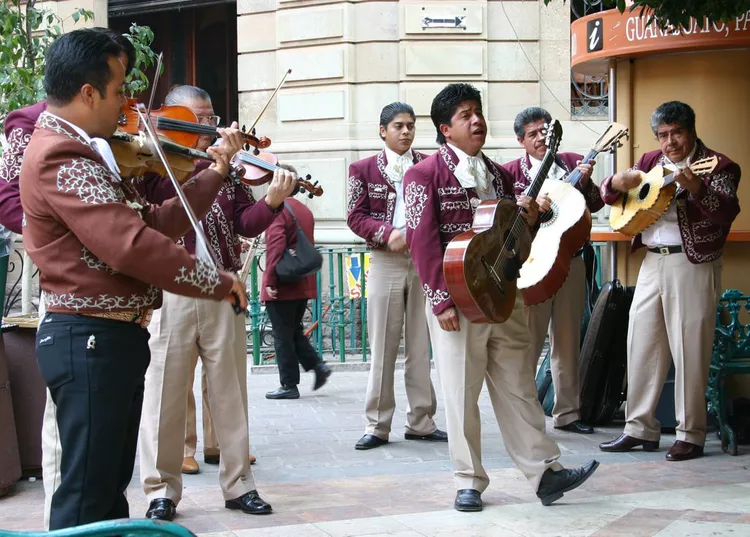1. UNESCO’s Intangible Heritage of Mexico
2. Mariachi, String Music, Song and Trumpet
3. Parachicos in the Traditional January Feast of Chiapa de Corzo
4. Pirekua, Traditional Song of the P’urhépecha
5. Traditional Mexican Cuisine
6. Indigenous Festivity Dedicated to the Dead
7. Ritual Ceremony of the Voladores
8. Places of Memory and Living Traditions of the People of Tolimán
9. Charreria Equestrian Tradition
The UNESCO (United Nations Educational, Scientific and Cultural Organization) maintains a list of World Heritage Sites along with the Intangible Cultural Heritage of Humanity. This list highlights traditions and living expressions passed down through generations, encompassing oral traditions, performing arts, social practices, rituals, festive events, and knowledge related to nature and the universe. Below are the elements of Mexican culture recognized by UNESCO as part of this intangible cultural heritage:
Mariachi, String Music, Song and Trumpet

Originating from the Mexican state of Jalisco, mariachi is a traditional genre of music that is a cornerstone of Mexican cultural identity. Traditional mariachi ensembles typically consist of trumpets, violins, the vihuela, and the “guitarrón” (a type of bass guitar). These groups usually feature four or more musicians dressed in charro attire. In modern times, mariachi music encompasses a wide repertoire reflecting diverse regional styles and musical genres.
Parachicos in the Traditional January Feast of Chiapa de Corzo

The dance of the Parachicos is integral to the Fiestas de Enero (January Festival) in Chiapa de Corzo, located in the state of Chiapas. This dance acts as a communal tribute to the saints honored during this celebration, namely Our Lord of Esquipulas, Saint Anthony Abbot, and Saint Sebastian, the latter receiving special recognition.
The dancers adorn themselves with intricately carved wooden masks, vibrant headdresses, and colorful serapes. Children actively participate, learning the dance and its significance. According to UNESCO, “The dance of the Parachicos during the Great Feast embraces all spheres of local life, promoting mutual respect among communities, groups, and individuals.”
Pirekua, Traditional Song of the P’urhépecha

Pirekua refers to the traditional music of the indigenous Purepecha communities in Michoacán, originating from the 16th century. This genre represents a fusion of indigenous culture, particularly language, with Spanish colonial string and wind instruments.
The vocalists, known as pireris, perform in the indigenous language and Spanish, addressing a variety of themes that encompass love, social issues, politics, and historical remembrance. These songs foster dialogue among singing communities, reinforcing social bonds.
Traditional Mexican Cuisine

Traditional Mexican cuisine is crucial to the cultural identity of communities that nurture and preserve it across generations.
Farming methods like milpa and cooking techniques such as nixtamalization, alongside unique utensils and community rituals, contribute to the comprehensive cultural model of Mexican cuisine.
The transmission of culinary traditions reinforces community ties and expresses group identity through the art of food preparation.
Indigenous Festivity Dedicated to the Dead

El Día de Los Muertos (Day of the Dead) is a significant occasion when Mexicans commemorate their deceased loved ones. This annual celebration occurs from October 31 to November 2, during which it is believed that the spirits of the dead return to visit their families. Special offerings are prepared to welcome these spirits.
Ritual Ceremony of the Voladores

The ceremony of the Voladores (meaning ‘flying men’) is a fertility dance performed by various ethnic groups throughout Mexico and Central America, particularly by the Totonac people in Veracruz. This ritual features five men around a tall pole.
The dancers leap from the pole, suspended by ropes that spiral around it, gracefully descending to the ground. This ritual serves to honor the earth, the passage of time, and the community’s place within the cosmos.
Places of Memory and Living Traditions of the People of Tolimán

The Otomi-speaking communities in Queretaro identify themselves as descendants of the Chichimecas, perceiving themselves as guardians of sacred lands.
These communities uphold traditions that reflect a profound connection to their environment, conducting annual pilgrimages, honoring their forebears, and celebrating their shared heritage.
Inscribed on UNESCO’s list of intangible cultural heritage in 2009, the “Places of memory and living traditions of the Otomí-Chichimecas people of Tolimán: the Peñá de Bernal, guardian of a sacred territory” highlight their rich cultural identity.
Charreria Equestrian Tradition

Often referred to as Mexico’s national sport, charrería (or la charreada) has evolved from the livestock herding practices prevalent among Mexican communities.
Charros and charras showcase their prowess in roping, riding, and reining. Their attire and the necessary equipment, such as saddles and spurs, are crafted by local artisans, making them valuable components of this traditional practice. Charrería significantly contributes to the cultural identity of the communities that uphold it.





